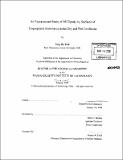| dc.contributor.advisor | Mario J. Molina. | en_US |
| dc.contributor.author | Park, Jong-Ho, 1973- | en_US |
| dc.contributor.other | Massachusetts Institute of Technology. Dept. of Chemistry. | en_US |
| dc.date.accessioned | 2008-12-11T18:25:42Z | |
| dc.date.available | 2008-12-11T18:25:42Z | |
| dc.date.copyright | 2008 | en_US |
| dc.date.issued | 2008 | en_US |
| dc.identifier.uri | http://hdl.handle.net/1721.1/43775 | |
| dc.description | Thesis (Ph. D.)--Massachusetts Institute of Technology, Dept. of Chemistry, 2008. | en_US |
| dc.description | Vita. | en_US |
| dc.description | Includes bibliographical references. | en_US |
| dc.description.abstract | The effect of relative humidity (RH) on OH uptake by surfaces of tropospheric importance was investigated. Due to diffusion limitation conditions, experiments were performed with parallel reactors packed with beads and using a surface dilution technique. A virtual cylindrical reactor approximation was developed to further quantify and confirm the reaction probability of OH for the surfaces of interest. While OH exposure of hydrophobic organic surfaces (paraffin wax, pyrene, and methane soot) did not result in measurable change in their relative hydrophilic properties, the presence of water vapor enhanced the OH reactivity on a hydrophilic organic surface (glutaric acid). The RH effect on OH uptake by sea salt and its components was dependent on the nature of the cations. Redistribution of surface ions under humid environments caused changes in pH on the inorganic surfaces, thereby influencing the rate-determining step in the reaction mechanism of heterogeneous OH uptake. This segregation effect explains why the RH effect on OH uptake by sea salt is determined by MgCl2 rather than NaC1. Experimental evidence suggests that adsorbed water on the surfaces of SiO2 and A1203 is responsible for enhancement in OH reactivity with mineral dust surfaces under high humidity conditions. Mass spectra of the gas-phase species produced from the heterogeneous reaction of OH with NaCl were obtained in order to characterize the reaction products and the kinetic mechanism. Evidence for gas-phase HC1, supplemented with kinetics modeling and experiments on heterogeneous 03 reactivity strongly suggest that C12, sole product of the heterogeneous reaction, transforms to HCI in the presence of H radicals. | en_US |
| dc.description.abstract | (cont.) The C12 yields per OH collision were determined to be 0.020 and 0.022 at 0% and 6% of RH, respectively. Enhancement in C12 production was observed under wet conditions, consistent with a measured chlorine deficit on the NaCl surface. Two alternate reaction mechanisms are proposed to describe the heterogeneous OH uptake by NaC1. | en_US |
| dc.description.statementofresponsibility | by Jong-Ho Park. | en_US |
| dc.format.extent | 170 leaves | en_US |
| dc.language.iso | eng | en_US |
| dc.publisher | Massachusetts Institute of Technology | en_US |
| dc.rights | M.I.T. theses are protected by
copyright. They may be viewed from this source for any purpose, but
reproduction or distribution in any format is prohibited without written
permission. See provided URL for inquiries about permission. | en_US |
| dc.rights.uri | http://dspace.mit.edu/handle/1721.1/7582 | en_US |
| dc.subject | Chemistry. | en_US |
| dc.title | An experimental study of OH uptake by surfaces of tropospheric importance under dry and wet conditions | en_US |
| dc.type | Thesis | en_US |
| dc.description.degree | Ph.D. | en_US |
| dc.contributor.department | Massachusetts Institute of Technology. Department of Chemistry | |
| dc.identifier.oclc | 260520487 | en_US |
